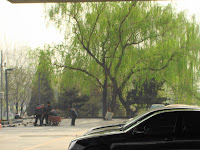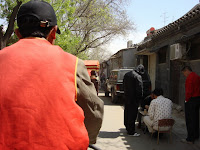After our visit to the Hutongs we visited a "Traditional Chinese Pharmacy". Here we heard a lecture regarding Traditional Chinese Medicine from one of the practitioners. The talk was very interesting, especially the theories about disease origins and the importance of keeping the body systems in balance. (
He associated eczema with problems with the spleen.)
Several in our group took advantage of the free consultations and departed with pricey recommended remedies.
Next stop, THE FORBIDDEN CITY
I'll list some facts about The Forbidden City.
Construction began in 1406
It was home to emperors of the Ming and Qing dynasties until 1911
Ordinary people were not allowed to enter the City until 1925
It is surrounded by a 52 ft wide moat, a 30 ft high wall, and contains over 800 buildings
Most of the buildings have yellow-tiled roofs, red walls, gilded doors, vermillion colonnades and marble balustrades
The buildings face south in accordance with feng shui principals
The stature of the main buildings is defined by the number of animals on the roof ridges
We entered from the north through the Gate of Divine Might into the Inner Court, the home of the emperor and his family. At the center of the Court is a set of three halls, The Palace of Earthly Tranquility, Hall of Union, and Palace of Heavenly Purity.
 In the Outer Court, where the emperor handled court affairs, were the Hall of Preserving Harmony, Hall of Central Harmony, and Hall of Supreme Harmony. The three buildings were constructed with double-eaved roofs and rest on three-tiered marble terraces. The doors and steps are always in odd numbers. The Hall of Supreme Harmony, the tallest and most magnificent building in the Forbidden City, is the largest surviving wooden structure in China. The vast courtyard in front of the Hall of Supreme Harmony, The Sea of Flagstones accommodated up to 100,000 people on festive occasions. When the emperor appeared here all in attendance prostrated themselves nine times. The courtyard symbolized the great power of imperial rule.
This is a bit of interesting information:
"The number "nine" carried a special significance in old China. Ancient Chinese regarded odd numbers as being masculine and even numbers as being feminine. "Nine", which is the largest single digit number was taken to mean the "ultimate masculine" and was, therefore, symbolic of the supreme sovereignty of the emperor. For this reason, the number "nine" (or its multiples) is often employed in palace structures and designs. A noticeable example is the number of studs on palace gates. The studs are usually arranged in nine rows of nine each, totaling eighty-one."
In the Outer Court, where the emperor handled court affairs, were the Hall of Preserving Harmony, Hall of Central Harmony, and Hall of Supreme Harmony. The three buildings were constructed with double-eaved roofs and rest on three-tiered marble terraces. The doors and steps are always in odd numbers. The Hall of Supreme Harmony, the tallest and most magnificent building in the Forbidden City, is the largest surviving wooden structure in China. The vast courtyard in front of the Hall of Supreme Harmony, The Sea of Flagstones accommodated up to 100,000 people on festive occasions. When the emperor appeared here all in attendance prostrated themselves nine times. The courtyard symbolized the great power of imperial rule.
This is a bit of interesting information:
"The number "nine" carried a special significance in old China. Ancient Chinese regarded odd numbers as being masculine and even numbers as being feminine. "Nine", which is the largest single digit number was taken to mean the "ultimate masculine" and was, therefore, symbolic of the supreme sovereignty of the emperor. For this reason, the number "nine" (or its multiples) is often employed in palace structures and designs. A noticeable example is the number of studs on palace gates. The studs are usually arranged in nine rows of nine each, totaling eighty-one."
 We exited the Forbidden City through the Meridian Gate after crossing one of the five bridges over Inner Golden Water River.
We exited the Forbidden City through the Meridian Gate after crossing one of the five bridges over Inner Golden Water River.
 The Tiananmen Gatehouse is decorated with a portrait of Mao Zedong in the center with two placards on either side reading, "Long live the People's Republic of China" and "Long live the great unity of the world's peoples".
The Tiananmen Gatehouse is decorated with a portrait of Mao Zedong in the center with two placards on either side reading, "Long live the People's Republic of China" and "Long live the great unity of the world's peoples".





















































